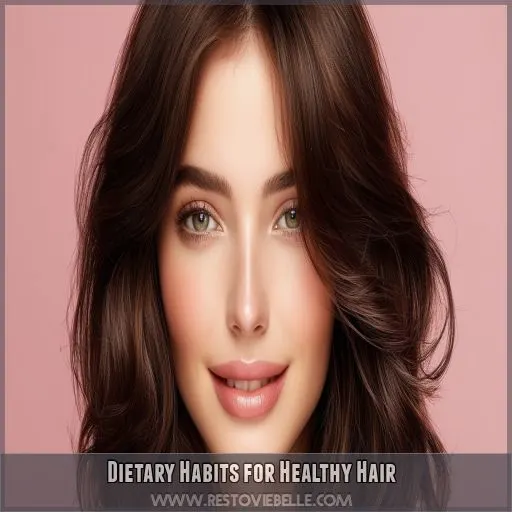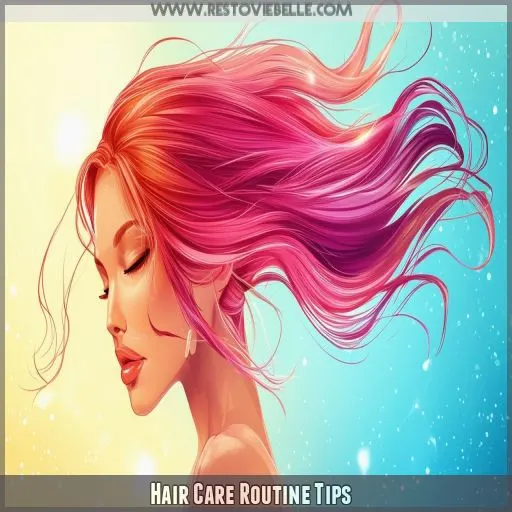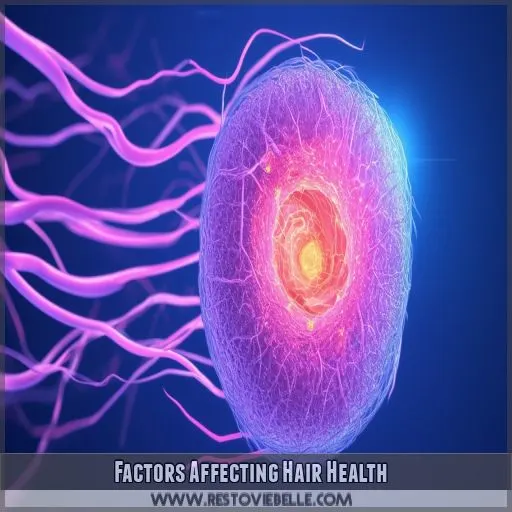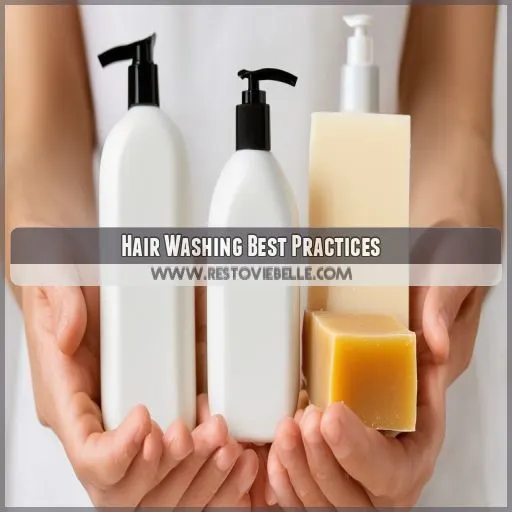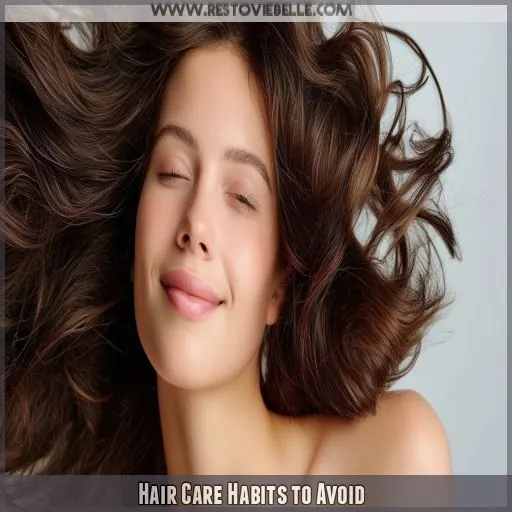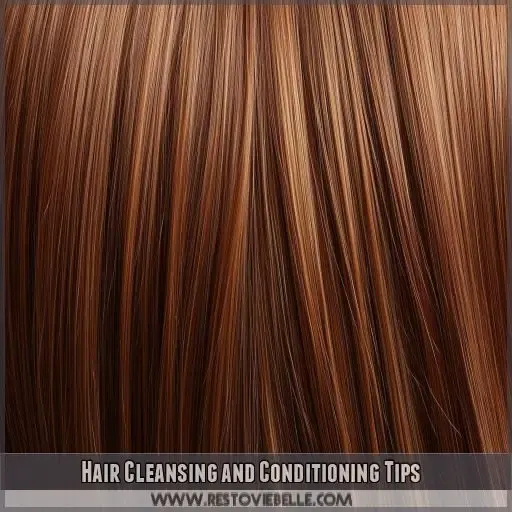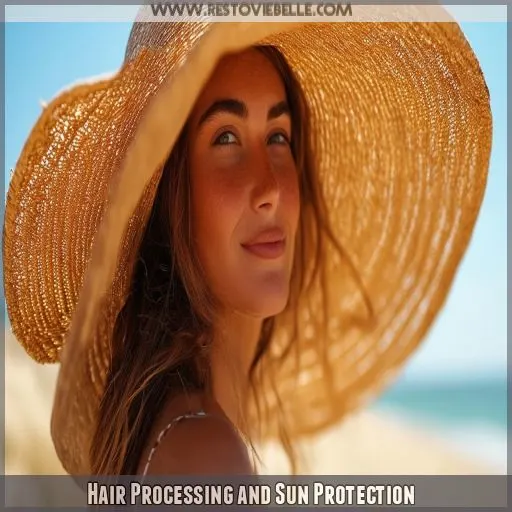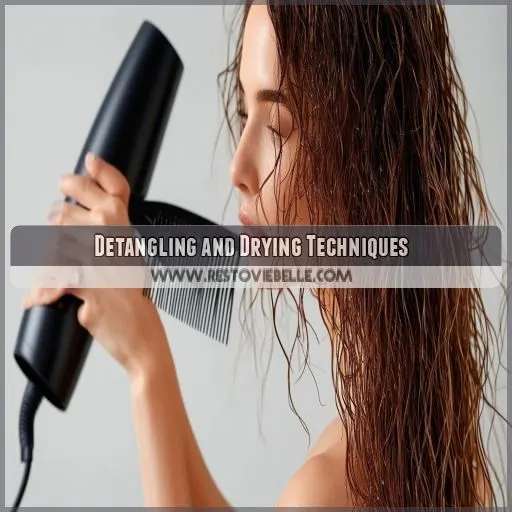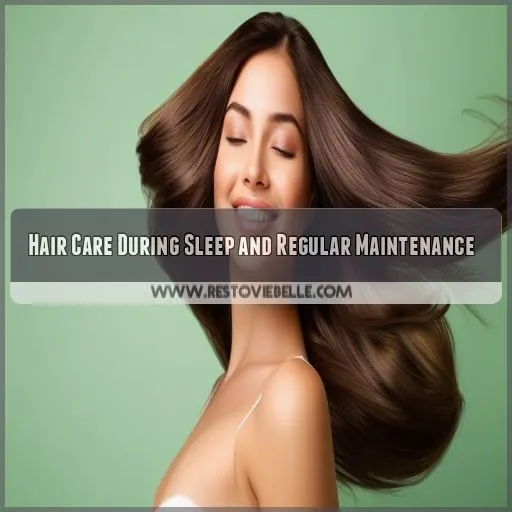This site is supported by our readers. We may earn a commission, at no cost to you, if you purchase through links.
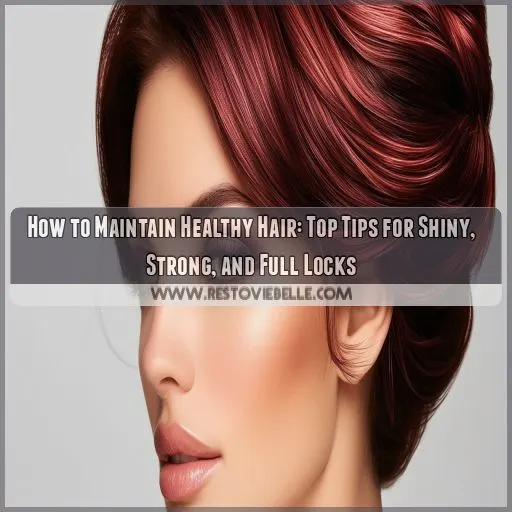 Get and maintain good health for your hair; it’s not solely about the products, but great care from within.
Get and maintain good health for your hair; it’s not solely about the products, but great care from within.
In this article are some very useful tips on how to achieve shiny, strong, full hair by adopting good dietary habits, using effective hair care routine strategies, and taking measures to protect your hair against damage from many sources.
Learn how to personalize your haircare routine, avoid those bad practices, and adopt techniques or ways that keep your hair glowing and strong so that you will feel even more assured and develop your personal style.
Table Of Contents
- Key Takeaways
- How to Maintain Healthy Hair?
- Dietary Habits for Healthy Hair
- Hair Care Routine Tips
- Factors Affecting Hair Health
- Hair Washing Best Practices
- Hair Protection Strategies
- Hair Care Habits to Avoid
- Hair Cleansing and Conditioning Tips
- Hair Processing and Sun Protection
- Detangling and Drying Techniques
- Hair Care During Sleep and Regular Maintenance
- Frequently Asked Questions (FAQs)
- How can I keep my hair healthy naturally?
- How can I improve my hair health?
- How do I get my hair healthy again?
- How can I keep my hair good everyday?
- How can I stop wasting product?
- What order should I use my hair products?
- How can I treat fine hair that doesnt hold a curl?
- What’s your best suggestion for addressing dull, ratty hair?
- How can I identify and manage frizz causes?
- Conclusion
Key Takeaways
- Feed your hair from the inside out: Nourish your locks with a balanced diet rich in protein, vitamins, and healthy fats. Your hair will thank you for the TLC!
- Be gentle with your mane: Avoid harsh chemicals, limit heat styling, and get regular trims to keep your locks strong and lustrous. Treat your hair like the delicate flower it is!
- Personalize your hair care routine: Tailor your shampooing and conditioning routine to your specific hair type, using the right products to meet its needs. Every head of hair is unique, so give yours the customized care it deserves.
- Protect your hair from the elements: Shield your locks from the sun’s harmful rays and chlorine’s damaging effects. A little extra care goes a long way in keeping your hair healthy and vibrant.
How to Maintain Healthy Hair?
A diet with a balance of protein, biotin, omega-3, vitamin C, and zinc is what one needs to eat to keep healthy locks.
Drink plenty of water and consume lean proteins, leafy greens, fruits, and nuts that are full of nutrients.
Use hair type-specific shampoo and conditioner. Add dry shampoo for oil control and giving moisture by adding a leave-in mask.
Reduce your heat setting when using heat styling tools and use protective products to protect your hair from damage.
Lifestyle habits—that is to say, reducing alcohol, managing stress, and getting enough sleep—go a huge way in forming these.
For more tips on how to have shiny and strong hair, keep going—your hair thanks you!
Dietary Habits for Healthy Hair
Maintaining healthy hair starts with a balanced diet rich in protein, essential nutrients, and hydration. Aim for at least 45g of protein daily, eat a variety of nutrient-dense foods like lean meats, fish, nuts, vegetables, and fruits, and drink plenty of water.
Protein Intake
To support healthy hair, aim for 45g of protein daily from lean meats, poultry, fish, beans, and eggs. Protein nourishes hair follicles and promotes strong, resilient strands.
Essential Nutrients
For healthy hair, focus on nutrients like biotin, omega-3, vitamin C, and zinc. These nutrients support hair strength and growth. Include eggs, nuts, fish, leafy greens, and whole grains in your diet. Implementing these hair care tips can enhance your routine.
Hydration and Nutrient-Dense Foods
Boost your hair’s health by increasing your intake of nutrient-dense foods like lean proteins, leafy greens, fruits, and nuts. Stay hydrated by drinking plenty of water throughout the day for stronger, shinier locks.
Hair Care Routine Tips
To maintain healthy hair, it’s important to tailor your shampooing and conditioning routine to your specific hair type, using the right products to meet its needs. Additionally, be cautious with heat styling tools and adopt gentle hair maintenance practices to prevent damage and keep your locks looking their best.
Shampooing and Conditioning
Shampooing and conditioning the hair are two most prominent steps toward perfect health for your locks. Tailor it especially toward your specific hair type. Between washes, use dry shampoo for oil absorption and a leave-in mask for extra moisture. Shine mist adds instant polish to any hairstyle.
Suitable Products for Hair Type
This means opting for products based on your hair type. Hair porosity, texture, and volume are things to consider in a product. Look out for ingredients that promote good scalp health. Dry shampoo will keep oil at bay, leave-in hair masks will provide hydration, and gloss mist adds shine.
Heat Styling and Hair Maintenance
To prevent heat damage and hair breakage:
- Use the lowest heat setting on styling tools.
- Apply a heat protectant spray before styling.
- Limit usage of heat styling tools.
- Air dry whenever possible to maintain hair texture and health.
Factors Affecting Hair Health
Maintaining healthy hair requires attention to your lifestyle, as factors like diet and stress can impact hair health. Certain medications can also affect the condition of your hair, so managing stress and understanding how your health influences your hair is essential.
Lifestyle and Health Impacts
Lifestyle choices like overconsumption of alcohol and low-calorie diets can negatively impact hair health. Manage stress levels and maintain thyroid function to promote strong, healthy hair growth.
Medication Effects
Some medications can impact your hair health, leading to thinning or hair loss.
- Blood thinners
- Heart medications
- Antidepressants
- High blood pressure drugs
- Arthritis treatments
Be aware of these potential side effects and consult your doctor.
Stress Management
Stress levels are very essential to be managed for good hair growth. Identify your sources of stress and adapt stress-coping mechanisms such as breathing exercises, meditation, or yoga that help your body to cope up with it. Enhance your stress-relieving activities and ensure you get the required amount of sleep daily. Balanced management of stress reflects shinier and healthier hair.
Hair Washing Best Practices
Wash your hair according to your scalp’s needs, focusing primarily on cleansing the scalp. Apply conditioner only to the ends to avoid weighing down the roots and to keep your hair hydrated.
Frequency and Scalp Focus
Wash oily hair frequently enough to clean the scalp and keep it healthy.
Massage your scalp with your fingertips while shampooing to get blood flow and eliminate wastes.
Wash in lukewarm—majorly not scalding hot—temperatures as these may strip off natural oils in the hair.
Use shampoos with gentle ingredients that are sulfate-free and represent what your hair type demands.
Conditioner Application
Apply conditioner to the mid-lengths and ends, avoiding the scalp. For extreme hydration, apply as a leave-in. Be conscious of your hair type and follow up based on that.
Include hair masks once or twice a week for deep nourishment. This will help keep your hair nice and full of moisture without oiliness and will thus look very shiny and manageable.
Hair Protection Strategies
Protect your hair from chlorine by wetting it and applying conditioner before swimming, and always wear a swim cap to minimize damage. To prevent heat damage, limit the use of styling tools and opt for lower heat settings whenever possible.
Chlorine and Sun Protection
Protect your locks from chlorine and sun damage. Before diving into the pool, wet your hair, then put on some leave-in conditioner to coat your strands. Use a swim cap to minimize the amount of exposure.
After you swim, wash your hair with swimmers shampoo to remove as many harsh chemicals from your locks as possible.
Sun Protection Use a hat or products that include SPF in them for protection.
Avoiding Heat Styling Tools
Consider heatless hairstyles to prevent hair damage. Embrace braids, buns, and natural substitutes for curls. Opt for styling alternatives like air-drying or using protective products. Remember, continuous heat exposure can strip moisture and cause breakage. By adopting these protective measures, you can maintain your hair’s health and shine without risking unnecessary harm.
Hair Care Habits to Avoid
Avoid brushing your hair while it’s wet to prevent breakage, and opt for loose hairstyles like low ponytails to reduce strain on your strands. Be cautious with frequent chemical treatments like dyeing or perming, as they can cause significant damage over time.
Brushing Techniques
Avoid brushing wet hair to prevent breakage. Use a wide-tooth comb instead. Brush hair when dry to distribute natural oils. Sleep on a silk or satin pillowcase to reduce friction and tangles overnight.
Hairstyle Choices
Choose hairstyles that protect your hair’s health. Avoid tight ponytails and braids that can cause breakage. Opt for styles that suit your hair length, color, and texture. Be cautious with hair extensions to prevent damage.
Overprocessing Precautions
Avoid overprocessing to prevent color fading, dye patchiness, and breakage. Limit the use of heat tools and harsh chemicals. Opt for low-heat settings and gentle hair care products to maintain the integrity of your locks and prevent damage.
Hair Cleansing and Conditioning Tips
Washing your hair less frequently can benefit the natural oils within. Also, try to condition from mid-length to the end and work up toward the scalp.
Frequency and Conditioning Techniques
The frequency for shampooing depends on your hair type: daily in oily hair, less frequently on dry or treated hair.
Be more focused on the scalp during the time of shampooing.
With conditioner application, work from mid-lengths to ends, avoiding the scalp.
This way, hydration will be achieved and oiliness is reduced, allowing one’s locks the moisturizing and protection it requires.
Hair Masks and Heat Protection
Using hair masks regularly can deeply condition and strengthen your strands. Focus on these key steps:
- Choose the right mask for your hair type.
- Apply to damp hair from mid-lengths to ends.
- Leave the mask on for 10-15 minutes.
- Rinse thoroughly with cool water.
For heat protection, always use a quality heat protectant before styling.
Hair Processing and Sun Protection
Minimizing how often you process your hair, such as dyeing or perming, helps reduce damage and keep it strong. Protect your hair from the sun and chlorine by using conditioners or leave-in masks, and wearing a swim cap while swimming.
Minimizing Hair Processing
Reduce hair damage by limiting hair dyes, chemical perms, bleach treatments, and keratin treatments. Overprocessing weakens hair over time.
| Avoid | Embrace |
|---|---|
| Frequent dyeing | Natural colors |
| Harsh perms | Gentle styles |
| Regular bleaching | Deep conditioning |
| Extensions | Hair masks |
| Excessive keratin treatments | Scalp massages |
Less is more for vibrant, strong hair.
Sun and Chlorine Protection
Protect your hair from the sun and chlorine to maintain its health. Simple strategies include:
- Wearing a swim cap
- Using a deep conditioner post-swim
- Applying leave-in conditioners or hair masks
- Avoiding excessive use of heat styling tools
- Covering your hair with a hat in strong sunlight.
These tips keep your hair vibrant and damage-free.
Detangling and Drying Techniques
Before washing your hair, be sure to gently brush or finger comb through any tangles to prevent further damage during the cleansing process. When drying your hair, avoid rubbing it vigorously with a towel, and instead, gently squeeze and pat it dry to preserve the hair’s natural moisture and texture.
Pre-Wash Detangling
Before washing, gently detangle your hair using a wide-tooth comb or your fingers. This pre-wash combing helps minimize breakage when wet. Start from the tips and work your way up to roots. Brushing before washing sets the stage for easier cleaning and conditioning. Remember to be gentle; your hair will thank you.
Proper Drying Methods
After washing, follow these drying methods:
- Air drying: Let hair dry naturally to prevent heat damage.
- Towel drying: Gently squeeze water out, don’t rub to avoid frizz.
- Blow drying: Use the lowest heat setting and direct air flow downwards.
- Minimize heat: Limit use of heat styling tools for healthier hair.
Hair Care During Sleep and Regular Maintenance
For nice hair, protect it while sleeping by braiding or covering the hair and not allowing it to mix and cause tangles and breaks. Balanced diets rich in nutrients, accompanied by regular haircuts, will help keep your hair strong and shining.
Nighttime Care
What do you do at night? Braid your hair or wear protective hairstyles. Apply a silk pillowcase or bonnet to reduce friction. Apply hair oils for nourishment and protection of strands. Just these small steps will ensure waking up with smooth, strong, ready-to-style hair.
Regular Haircuts and Healthy Lifestyle
Get regular trims to remove split ends and maintain your hair’s healthy shape. Pair this with a balanced diet rich in hair-nourishing nutrients to support strong, vibrant locks. Prioritize scalp health too – massage it gently to promote blood flow and hair growth. Your lifestyle choices play a big role in your hair’s wellbeing.
Frequently Asked Questions (FAQs)
How can I keep my hair healthy naturally?
Nourish your hair naturally by eating a balanced diet rich in protein, vitamins, and healthy fats. Avoid harsh chemicals, limit heat styling, and get regular trims to keep your locks strong and lustrous.
How can I improve my hair health?
Want Rapunzel-like locks? Prioritize a protein-rich diet, ditch harsh shampoos, and opt for wide-tooth combs. Hydrate like it’s your job, embrace heat-free styling, and trim regularly. Your hair will thank you.
How do I get my hair healthy again?
To get your hair healthy again, consume a balanced diet of lean proteins, fruits, and vegetables. Hydrate well, limit heat styling, use suitable hair products, avoid tight hairstyles, and trim regularly to prevent split ends.
How can I keep my hair good everyday?
Unleash the secret for hair heaven! Treat your locks daily with a personalized routine, nourishing products, and smart styling habits. Unlock the key to lustrous, resilient locks that make heads turn everywhere you go.
How can I stop wasting product?
To stop wasting product, dispense a small amount initially and gradually add if needed. Focus on applying only to areas requiring attention. Use products targeted to your specific hair type to ensure effective and efficient use.
What order should I use my hair products?
Start with shampoo, then apply conditioner focusing on mid-lengths to ends. Use a leave-in conditioner or mask for extra moisture. Finally, apply products like styling cream or hair oil, followed by heat protectant before styling.
How can I treat fine hair that doesnt hold a curl?
To treat fine hair that doesn’t hold a curl, use a volumizing mousse before blow-drying and curl-enhancing products after. Avoid heavy conditioners which can weigh down fine strands. Finish with a light-hold hairspray to set the style.
What’s your best suggestion for addressing dull, ratty hair?
Think of your hair like a garden needing care. Trim split ends regularly, nourish with a balanced diet, use deep conditioners, and protect from heat and sun. These steps will breathe life back into your locks.
How can I identify and manage frizz causes?
Identify frizz causes by checking for broken strands, dryness, humidity exposure, or using harsh products. Manage frizz with hydrating conditioners, avoiding heat styling, protective hairstyles, and using anti-frizz serums or leave-in conditioners.
Conclusion
Healthy hair is like a beautiful, flourishing garden; what I mean is that it requires constant and good upkeep. Adapt these easy strategies as outlined in this article on growing hair that turns heads—vibrant, strong, full of life.
This promises maintaining a balanced diet coupled with personal care of the hair, plus protective measures put in place to keep locks shining. Apply these simple tips to help you bring out your real beauty confidently through these easy hints on the secret behind how to maintain healthy hair.

